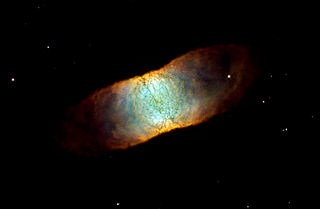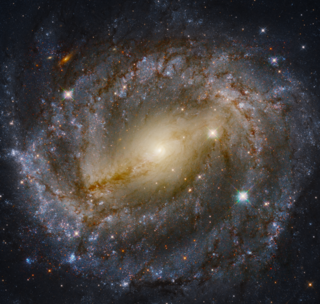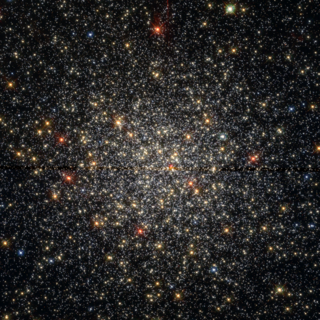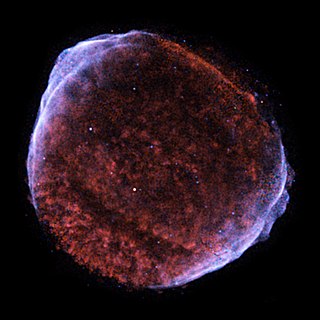 W
WLupus is a constellation of the mid-Southern Sky. Its name is Latin for wolf. Lupus was one of the 48 constellations listed by the 2nd-century astronomer Ptolemy, and it remains one of the 88 modern constellations, but was long an asterism associated with the just westerly, larger constellation Centaurus.
 W
WAlpha Lupi is a blue giant star, and the brightest star in the southern constellation of Lupus. According to the Bortle Dark-Sky Scale, its apparent visual magnitude of 2.3 makes it readily visible to the naked eye even from highly light-polluted locales. Based upon parallax measurements made during the Hipparcos mission, the star is around 460 light-years from the solar system. It is one of the nearest supernova candidates.
 W
WBeta Lupi, or Kekouan, is a star in the southern constellation of Lupus. It has an apparent visual magnitude of 2.7, making it readily visible to the naked eye. Based upon parallax measurements, this star is located at a distance of about 383 light-years from Earth.
 W
WDelta Lupi is a star in the southern circumpolar constellation of Lupus. In traditional Chinese astronomy, it is "the 2nd (star) of the Cavalry Officer" (騎官二). With an apparent visual magnitude of 3.22, it is the fourth-brightest star in the constellation. The distance to this star has been measured using the parallax technique, yielding an estimate of roughly 900 light-years with a 15% margin of error.
 W
WEpsilon Lupi, Latinized from ε Lup, is a multiple star system in the southern constellation of Lupus. At an apparent visual magnitude of 3.41, Epsilon Lupi can be readily viewed from the southern hemisphere with sufficiently dark skies. It is the fifth-brightest star or star system in the constellation. Parallax measurements give a distance to this system of roughly 510 light-years.
 W
WGamma Lupi is a 3rd-magnitude, B-type blue giant star in the constellation of Lupus. It is also known in ancient Chinese astronomy as 騎官一 or "the 1st (star) of the Cavalry Officer". With a telescope, Gamma Lupi can be resolved into a binary star system in close orbit. This is known as the Gamma Lupi AB system, often abbreviated as γ Lupi AB or γ Lup AB. Gamma Lupi A is itself a spectroscopic binary with a period of 2.8081 days.
 W
WGQ Lupi b is a possible extrasolar planet, brown dwarf or Sub-brown dwarf orbiting the star GQ Lupi. Its discovery was announced in April 2005. Along with 2M1207b, this was one of the first extrasolar planet candidates to be directly imaged. The image was made with the VLT telescope at Paranal Observatory, Chile on June 25, 2004.
 W
WHD 139664 is a single star in the southern constellation of Lupus. It has the Bayer designation g Lupi; HD 139664 is the star's identifier from the Henry Draper Catalogue. It has a yellow-white hue and is visible to the naked eye with an apparent visual magnitude of 4.64. The star is located at a distance of 57 light years from the Sun based on parallax, and it is drifting closer with a radial velocity of −7 km/s. It is a member of the Hercules-Lyra Association of co-moving stars.
 W
WHD 142527 is a star in the constellation of Lupus. It is notable for its protoplanetary disk and its discovery has helped refine models of planet formation.
 W
WIC 4406 is a planetary nebula near the western border of the constellation Lupus, the Wolf. It has dust clouds and has the shape of a torus. Despite this, it looks somewhat rectangular because it is seen from its side as viewed from Earth, almost in the plane of its equator.
 W
WLupus-TR-3b is an extrasolar planet orbiting the star Lupus-TR-3. The planet was discovered in 2007 by personnel from the Harvard-Smithsonian Center for Astrophysics observing at the Siding Spring Observatory in Australia, by the transit method.
 W
WNGC 5643 is an intermediate spiral galaxy in constellation Lupus. It is located at a distance of circa 60 million light years from Earth, which, given its apparent dimensions, means that NGC 5643 is about 100,000 light years across. NGC 5643 has an active galactic nucleus and is a type II Seyfert galaxy.
 W
WNGC 5822 is an open cluster in the constellation Lupus.
 W
WNGC 5824 is a globular cluster in the constellation Lupus, almost on its western border with Centaurus. Astronomers James Dunlop (1826), John Herschel (1831) and E.E. Barnard (1882) all claim to have independently discovered the cluster. It is condensed and may be observed with small telescopes, but larger apertures are required to resolve its stellar core.
 W
WNGC 5882 is a small planetary nebula in the southern constellation of Lupus, positioned about 1.5° to the southwest of the star Epsilon Lupi. It was discovered by English astronomer John Herschel on July 2, 1834 from the Cape of Good Hope observatory. John L. E. Dreyer described it as "very small, round, quite sharp". It is located at a distance of approximately 7.7 kilolight-years from the Sun.
 W
WNGC 5927 is a globular cluster in the constellation Lupus. NGC 5927 has a diameter of about 12 arcminutes and an apparent magnitude of +8.86. Its Shapley–Sawyer Concentration Class is VIII, and it contains stars of magnitude 15 and dimmer.
 W
WNGC 5986 is a globular cluster of stars in the southern constellation of Lupus, located at a distance of approximately 34 kilolight-years from the Sun. It was discovered by Scottish astronomer James Dunlop on May 10, 1826. John L. E. Dreyer described it as, "a remarkable object, a globular cluster, very bright, large, round, very gradually brighter middle, stars of 13th to 15th magnitude". Its prograde–retrograde orbit through the Milky Way galaxy is considered irregular and highly eccentric. It has a mean heliocentric radial velocity of +100 km/s. The galacto-centric distance is 17 kly (5.2 kpc), which puts it in the galaxy's inner halo.
 W
WNu2 Lupi (ν2 Lup) is a 6th magnitude G-type main-sequence star located approximately 48 light-years away in the constellation of Lupus. The physical properties of the star are similar to those of the Sun, though Nu2 Lupi is significantly older.
 W
WThe Scorpius–Centaurus Association is the nearest OB association to the Sun. This stellar association is composed of three subgroups, whose its distance is about 130 parsecs or 420 light-years. Using improved Hipparcos data, Rizzuto and colleagues analysed nearby stars more closely, bringing the number of known members to 436. They doubt the need to add a subclassification because they found a more continuous spread of stars.
 W
WSN 1006 was a supernova that is likely the brightest observed stellar event in recorded history, reaching an estimated −7.5 visual magnitude, and exceeding roughly sixteen times the brightness of Venus. Appearing between April 30 and May 1, 1006 AD in the constellation of Lupus, this "guest star" was described by observers across the modern day countries of China, Japan, Iraq, Egypt, and the continent of Europe, and possibly recorded in North American petroglyphs. Some reports state it was clearly visible in the daytime. Modern astronomers now consider its distance from Earth to be about 7,200 light-years.
 W
WUpsilon Lupi, Latinized from υ Lupi, is a star system in the southern constellation of Lupus. It is faintly visible to the naked eye with an apparent visual magnitude of 5.37. Based upon an annual parallax shift of 8.02 mas as seen from Earth, it is located around 410 light years from the Sun. The two components of Upsilon Lupi share a common proper motion through space and most likely form a wide binary star system. As of 1945, the pair had an angular separation of 1.50 arc seconds along a position angle of 40°.
 W
WXi1 Lupi (ξ1 Lup, ξ1 Lupi) is a probable binary star in the southern constellation of Lupus. It is faintly visible to the naked eye with an apparent visual magnitude of 5.1, and forms a visual double star with Xi2 Lupi. Based upon an annual parallax shift of 23.60 mas as seen from Earth, it is located around 140 light years from the Sun. It is a member of the Upper Scorpius sub-group of the nearby Sco OB2 association.
 W
WXi2 Lupi (ξ2 Lup, ξ2 Lupi) is a member of a double star with Xi1 Lupi in the southern constellation of Lupus. As of 2004, the pair had an angular separation of 10.254 arc seconds along a position angle of 49.21°. Xi2 Lupi is visible to the naked eye with an apparent visual magnitude of 5.55. Based upon an annual parallax shift of 21.71 mas as seen from Earth, it is located roughly 150 light years from the Sun. It has a peculiar velocity of 14.3±1.9 km/s relative to its neighbors, and is probably (86% chance) a runaway star.